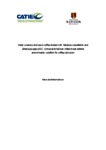Use este identificador para citar ou linkar para este item:
http://biblioteca.incaper.es.gov.br/digital/handle/item/2706Registro completo de metadados
| Campo DC | Valor | Idioma |
|---|---|---|
| dc.contributor.author | PADOVAN, M. da P. | pt_BR |
| dc.contributor.other | Maria da Penha Padovan, Incaper. | pt_BR |
| dc.date.accessioned | 2017-06-05T18:36:10Z | - |
| dc.date.available | 2017-06-05T18:36:10Z | - |
| dc.date.created | 2016 | pt_BR |
| dc.date.issued | 2017-06-05 | pt_BR |
| dc.identifier.other | 16044 | pt_BR |
| dc.identifier.uri | http://biblioteca.incaper.es.gov.br/digital/handle/item/2706 | - |
| dc.description | Water availability is predicted to be reduced and temperature to rise in the global climate change context. Future climate conditions may thus represent a serious risk for coffee cultivation especially in less favorable environment. Agroforestry has been postulated as a promising strategy to adapting to climate changes. Shade tree may minimize radiation and temperature near the soil surface and reduce soil evaporation. Shade tree may enhance infiltration, reduce runoff and increase rainfall water use efficiency by taking up water from deep soil layers. However, shade tree may reduce the water that reaches the soil by rainfall interception. Trees may consume additional water and can establish a competitive relationship depending on tree species characteristics, soil water availability, site conditions and management. In this experiment water dynamics and use was monitored in a mature agroforestry experiment where coffee shaded by a mixture of Tabebuia rosea and Simarouba glauca is compared to full sun coffee over 2012 and 2013. The water balance was obtained by two independent approaches: 1) measuring directly all components of water balance (trees and coffee transpiration; soil evaporation; rainfall interception); and 2) measuring changes in the soil water stock through Time Domain Reflectometers (TDR) probes. Agroforestry (AFS) showed greater transpiration and lower soil surface evaporation compared to full sun (FS). Shade tree did not represent a serious constraint for coffee water use during most of the period of the experiment. Coffee water consumption represented 75% of the total transpiration in agroforestry while Tabebuia rosea transpired 17% and Simarouba glauca 8%. Complementarity was demonstrated by root niche differentiation between coffee and Simarouba glauca that seemed to be more suitable as coffee shade tree compared to Tabebuia rosea. We also demonstrated high competition between coffee and shade tree when an atypical very dry season occurred. Transpiration was stabilized although the high evaporative demand and coffee leaf water potential reached its lowest value in AFS which suggested high level of coffee water stress. Adaptation strategies for coping with climate change using shade trees need to be devised taking into account this quantified information into account. | pt_BR |
| dc.language | en | pt_BR |
| dc.publisher | Turrialba, CATIE-BU, 2016. | pt_BR |
| dc.subject | Água | pt_BR |
| dc.subject | Café | pt_BR |
| dc.subject | Tabebuia rosea Bertol | pt_BR |
| dc.subject | Coffee | pt_BR |
| dc.subject | Water | pt_BR |
| dc.subject | Coffee cultivation | pt_BR |
| dc.subject | Dynamics | pt_BR |
| dc.title | Water dynamics and use in coffee shaded with Tabebuia rosea Bertol. and Simarouba glauca D.C. compared to full sun coffee in sub optimal environmental condition for coffee cultivation. | pt_BR |
| dc.type | -- | pt_BR |
| dc.ainfo.id | 15191 | pt_BR |
| dc.ainfo.lastupdate | 2017-06-05 | pt_BR |
| dc.ainfo.depositante | Catia Ribeiro Barcelos | pt_BR |
| dc.format.extent2 | 164 p. | pt_BR |
| Aparece nas coleções: | Memória Técnica do Incaper  | |
Arquivos associados a este item:
| Arquivo | Descrição | Tamanho | Formato | |
|---|---|---|---|---|
| BRT-Water-dynamics-and-use-in-coffee-shaded-wit-Tabebuia-rosea-Bertol.pdf | 3,6 MB | Adobe PDF |  Visualizar/Abrir |
Os itens no repositório estão protegidos por copyright, com todos os direitos reservados, salvo quando é indicado o contrário.
